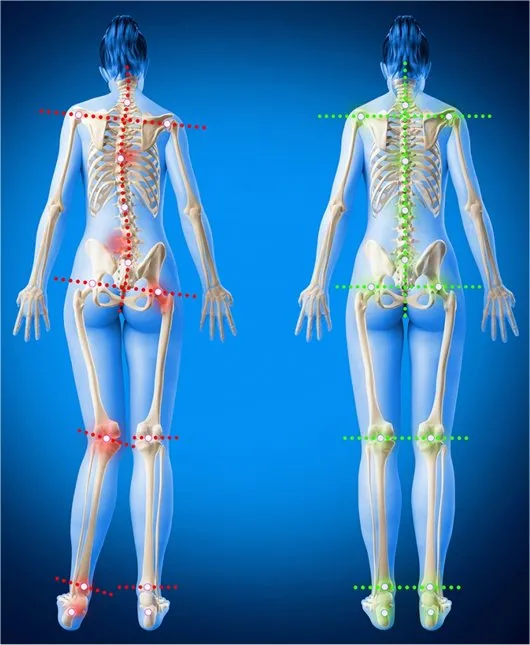
Posturology
Posturology is the study of the mechanisms involved in balance control and its dysfunctions. Indeed, far from being an anatomical given, maintaining an upright posture represents a true neurophysiological feat for humans.
To achieve this, humans have developed a postural regulation system that allows them to stand upright despite external constraints, orient themselves in space, and adjust their movements precisely. At every moment, this system ensures that the adopted posture is as close as possible to an ideal reference posture, economical in energy, and perfectly symmetrical in terms of muscle contractions.
A poor posture, regardless of its origin, is therefore more energy-intensive and inevitably leads to unnecessary, asymmetric, and often painful muscle contractions.
Principles of operation:
The postural regulation system utilizes information transmitted by numerous sensors located throughout the body to inform the brain about the nature of the environment and enable it to adjust the work of each muscle, ensuring that standing or walking occurs under optimal conditions. In this complex system, the eye and the foot are major entry points for postural regulation.
A misalignment of the foot (valgus, varus, etc.) or a slight ocular deviation will create an imbalance in the postural muscle chains and, consequently, a modification of posture (shoulder rotation, pelvic tilt, etc.). Numerous pathologies (lower back pain, neck pain, joint and muscle discomfort, headaches, dizziness, etc.) will then emerge as a consequence and not the cause of poor posture.
Role of the foot in postural regulation
The skin on the sole of the foot contains sensors sensitive to pressures on the order of micrograms. Their function is to inform the brain about the nature of the ground (hard, soft, even, rough, etc.) and the overall position of the body in space. For example, if the sensors under the forefoot are compressed, the brain will interpret this information as a forward fall and will mobilize the appropriate muscle groups to return to a balanced position.
Role of the podiatrist in postural treatment:
The main objective of the podiatrist, after a thorough analysis of the patient's static posture (too forward, too much to the right, pelvic tilt, tilted head, etc.), is to restore a position close to absolute verticality (postural invariant).
This postural reprogramming is achieved through the use of so-called posture insoles. These are custom-made orthotic insoles with elements not exceeding 3 mm in thickness.
These thin wedges act as sensorial lures, stimulating the pressure sensors beneath them and instructing the brain to adjust muscle tone in accordance with the received stimulations.
The choice of stimulation wedges helps rebalance muscle contractions to recenter the patient. This way, the patient adopts a new posture that is more comfortable and free from unnecessary contractions.
However, achieving a perfect posture can only be attained when the various organs that make up the postural regulation system are functioning perfectly. That's why it is not uncommon for the podiatrist, after the clinical examination, to refer the patient to an ophthalmologist, a dentist, or an osteopath.
Sources: Bernard Bricot's Global Postural Reprogramming / Philippe and Sylvie Villeneuve's API

